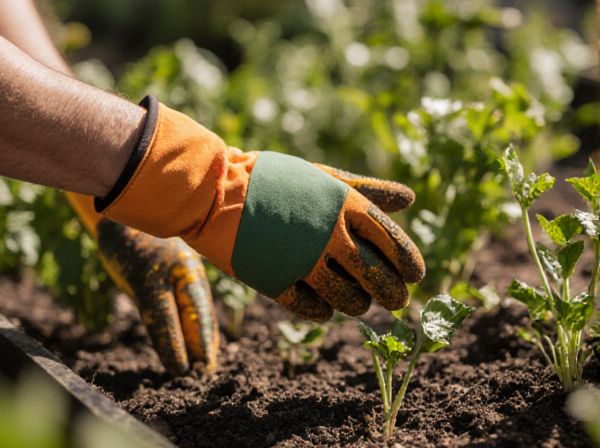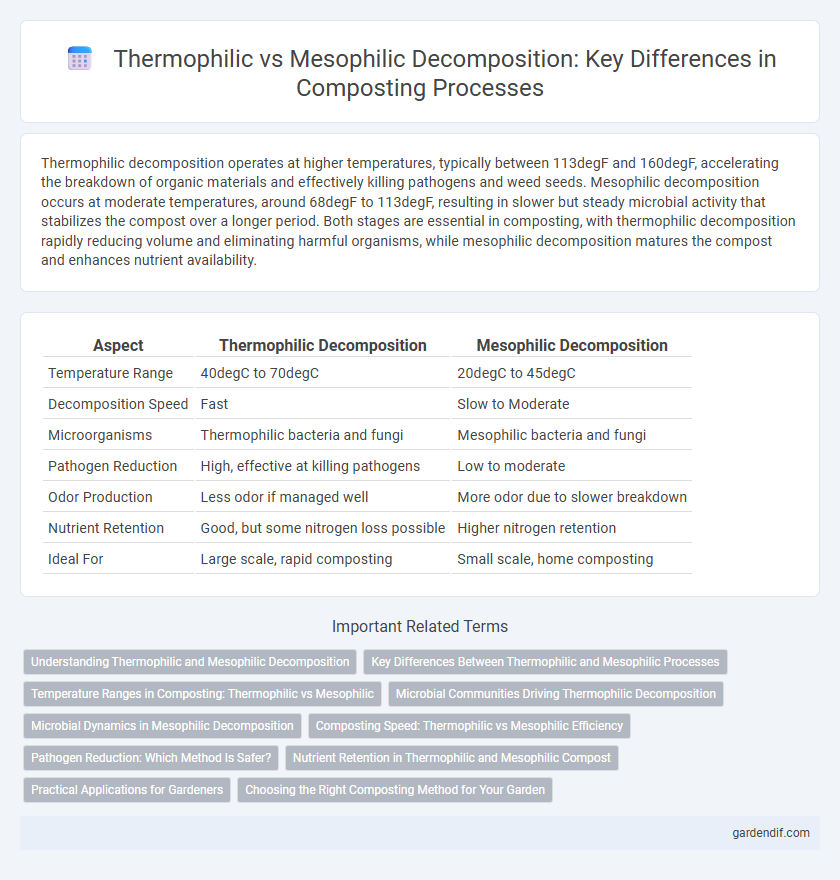
Thermophilic Decomposition vs Mesophilic Decomposition Illustration
Thermophilic decomposition operates at higher temperatures, typically between 113degF and 160degF, accelerating the breakdown of organic materials and effectively killing pathogens and weed seeds. Mesophilic decomposition occurs at moderate temperatures, around 68degF to 113degF, resulting in slower but steady microbial activity that stabilizes the compost over a longer period. Both stages are essential in composting, with thermophilic decomposition rapidly reducing volume and eliminating harmful organisms, while mesophilic decomposition matures the compost and enhances nutrient availability.
Table of Comparison
| Aspect | Thermophilic Decomposition | Mesophilic Decomposition |
|---|---|---|
| Temperature Range | 40degC to 70degC | 20degC to 45degC |
| Decomposition Speed | Fast | Slow to Moderate |
| Microorganisms | Thermophilic bacteria and fungi | Mesophilic bacteria and fungi |
| Pathogen Reduction | High, effective at killing pathogens | Low to moderate |
| Odor Production | Less odor if managed well | More odor due to slower breakdown |
| Nutrient Retention | Good, but some nitrogen loss possible | Higher nitrogen retention |
| Ideal For | Large scale, rapid composting | Small scale, home composting |
Understanding Thermophilic and Mesophilic Decomposition
Thermophilic decomposition occurs at high temperatures between 45degC and 70degC, accelerating organic matter breakdown through heat-loving microbes, resulting in faster compost maturation and pathogen elimination. Mesophilic decomposition takes place at moderate temperatures ranging from 20degC to 45degC, relying on mesophilic bacteria and fungi to initiate the composting process by breaking down easily degradable materials. Understanding the temperature ranges, microbial activity, and decomposition rates of thermophilic versus mesophilic phases is essential for optimizing compost quality and ensuring efficient nutrient cycling.
Key Differences Between Thermophilic and Mesophilic Processes
Thermophilic decomposition occurs at temperatures between 45degC and 70degC, accelerating organic matter breakdown through heat-loving microorganisms, while mesophilic decomposition functions optimally at 20degC to 45degC with microbes thriving in moderate conditions. Thermophilic processes rapidly reduce pathogens and weed seeds, enhancing compost sanitation, whereas mesophilic processes are slower and less effective at pathogen destruction but promote greater microbial diversity. The choice between thermophilic and mesophilic composting impacts nutrient cycling rates, organic matter stabilization, and overall compost quality.
Temperature Ranges in Composting: Thermophilic vs Mesophilic
Thermophilic decomposition occurs at temperatures between 45degC and 70degC, accelerating the breakdown of organic matter and killing pathogens and weed seeds in compost. Mesophilic decomposition takes place at lower temperatures, typically ranging from 20degC to 45degC, enabling the activity of different microbial communities that initiate the composting process. Understanding these temperature ranges is crucial for optimizing composting efficiency and ensuring effective stabilization of organic waste.
Microbial Communities Driving Thermophilic Decomposition
Thermophilic decomposition is driven by heat-loving microbial communities, primarily thermophilic bacteria and fungi, that thrive at temperatures between 45degC and 70degC, accelerating the breakdown of organic matter. These microbes generate intense heat, which not only speeds up composting but also helps eliminate pathogens and weed seeds, enhancing compost quality. In contrast, mesophilic decomposition involves microbes active at moderate temperatures (20degC to 45degC), resulting in slower organic matter degradation and less pathogen suppression.
Microbial Dynamics in Mesophilic Decomposition
Mesophilic decomposition involves microbial populations that thrive at moderate temperatures, typically between 20degC and 45degC, enabling a slower but steady breakdown of organic matter. The microbial dynamics in this phase are dominated by mesophilic bacteria and fungi, which facilitate the decomposition of simple carbohydrates, proteins, and lipids into smaller compounds. This microbial activity enhances nutrient availability and prepares the compost for the subsequent thermophilic phase.
Composting Speed: Thermophilic vs Mesophilic Efficiency
Thermophilic decomposition accelerates composting speed by operating at higher temperatures (45-70degC), which rapidly breaks down organic matter through heat-loving microbes, whereas mesophilic decomposition functions at moderate temperatures (20-45degC) resulting in slower organic matter breakdown. The heightened enzymatic activity during thermophilic composting enhances microbial metabolism, leading to faster nutrient release and reduced composting time, typically lasting a few weeks compared to months in mesophilic processes. However, mesophilic decomposition supports greater microbial diversity and stability, contributing to consistent compost quality over extended periods.
Pathogen Reduction: Which Method Is Safer?
Thermophilic decomposition reaches temperatures between 131degF and 160degF, effectively killing most pathogens and making it a safer method for composting contaminated organic waste. Mesophilic decomposition operates at lower temperatures, typically between 68degF and 113degF, which slows pathogen die-off and may allow some harmful microorganisms to survive. For applications requiring stringent pathogen reduction, thermophilic composting provides a more reliable and safer option.
Nutrient Retention in Thermophilic and Mesophilic Compost
Thermophilic decomposition maintains higher temperatures, accelerating organic matter breakdown and resulting in greater nitrogen mineralization, which supports enhanced nutrient retention in compost. Mesophilic decomposition operates at moderate temperatures, preserving more microbial diversity that aids in retaining a broader spectrum of micronutrients. Thermophilic compost generally exhibits higher concentrations of available nitrogen and phosphorus, while mesophilic compost retains more complex organic compounds contributing to long-term soil fertility.
Practical Applications for Gardeners
Thermophilic decomposition, operating at temperatures between 113degF and 160degF, accelerates the breakdown of organic matter and effectively kills weed seeds and pathogens, making it ideal for gardeners aiming for quick, sanitized compost. Mesophilic decomposition occurs at cooler temperatures, ranging from 68degF to 113degF, promoting gradual nutrient release and supporting beneficial microbial diversity that enhances soil health over time. Gardeners often combine both phases to optimize compost maturity, nutrient availability, and soil fertility for sustainable plant growth.
Choosing the Right Composting Method for Your Garden
Thermophilic decomposition operates at higher temperatures, typically between 113degF and 160degF, rapidly breaking down organic matter while effectively killing pathogens and weed seeds, making it ideal for large-scale garden composting. Mesophilic decomposition occurs at moderate temperatures, around 68degF to 113degF, supporting a diverse microbial community that excels in gradual nutrient release and is better suited for smaller or indoor garden compost setups. Selecting the appropriate composting method depends on garden size, desired composting speed, and the need for pathogen elimination to optimize soil health and plant growth.
Thermophilic Decomposition vs Mesophilic Decomposition Infographic

 gardendif.com
gardendif.com